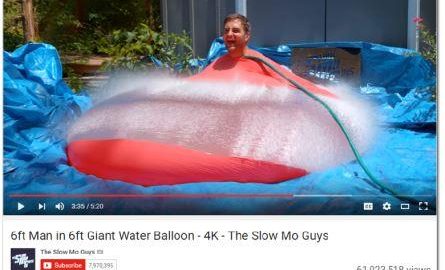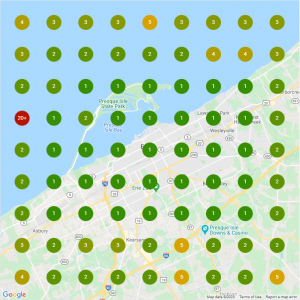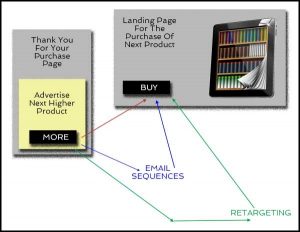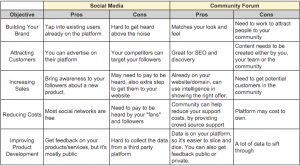When you hear the words “search engine optimization,” you likely think of Google. This makes sense, as Google is clearly the alpha dog when it comes to search engines, holding 63.8% of the market share. But there is also a second search engine that you should focus on to maximize your business’s exposure.
No, it’s not Bing. It’s YouTube.
Yes, YouTube is the second largest search engine in the world (and it just so happens that it is owned by the first).
In this article, you will learn how to optimize your YouTube videos for search. I will go over the basics of YouTube SEO, and even delve a bit into some more advanced hacks that most people never think to use.
Just like website search engine optimization, the strategies used for video SEO are universal regardless which platform is hosting your video (be it YouTube, Vimeo, DailyMotion or whatever else). However, given the size of YouTube, this is video platform I will focus on in this article.
But first, let’s talk about why you should even bother:
Benefits of Video
Message
First and foremost, video allows you to deliver your marketing message through a popular and growing medium. According to Cisco, by 2019, 80% of Internet traffic will come from video, surpassing any other channel. By creating and hosting videos on YouTube, your local business has the opportunity to tap into this growing channel.
In addition, different people prefer to consume content – and learn – in different ways; some people prefer to read a text-based article, while others prefer video. And very often, people who prefer video have no patience for text (and vice versa).
Expertise
When you capture the attention of new customers, video provides you with an additional opportunity to establish your local business as the expert. For example, if you are a plumber, you most likely already have a basic website that explains the offerings you provide and your local service area. You can take your strategy to a whole new level with a series of how-to videos.
Note: Many local businesses are often afraid to give away “trade secrets” in online videos by revealing how they would handle a job. In reality, all an online video series will do is show customers that you know what you are doing. Your customers aren’t suddenly going to start installing their new boilers and your competitors already know how to do this.
Google rankings
If you optimize your videos properly, you can rank them not just in YouTube, but that other search engine as well, Google.
Google owns YouTube, so it obviously wouldn’t mind you watching videos hosted there. Additionally, Google favors sites with a lot of authority in their rankings and there are very few sites as authoritative as YouTube.
However, for some smaller competition niches (like ultra-local keywords), you can also rank videos hosted on other platforms, such as Vimeo.
In general, there are specific types of content for which Google will favor video, and you will often see these come up in the results.
These are typically:
- How-to/instructional videos and tutorials
- Review videos
- Entertainment
How-to / instructional videos and tutorials
One of the great things about the internet is that you are one search query away from learning something new.
Below you will see the search engine result page for the query “how to change a tire.”

It’s clear that video has a lot of value with this type of search, as a video walk through would help a lot of people looking for help with this. This is why you will often find videos with “how-to” in searches. The one exception to this can be with recipe searches as Google recognizes large recipe sites and delivers those in the results.
Review videos
Review videos don’t have to be the traditional “talking head” style, where a happy customer tells the camera how great your local business is. As a general rule, these types of review videos work well for B2B companies that want to position themselves as an experienced and trusted partner.
With a little creativity, you can turn video product reviews into product demonstrations. You can see below that a beauty blogger posted a video review for L’Oreal pro-matte foundation, also demonstrating how she uses the product.

Entertainment
And finally, it’s pretty obvious that video is perfect entertainment.
In some instances, YouTube videos own all of the search results on Google, like this search for “cereal challenge” (below).

The clear win for small and local businesses here is the “how to” style video. However, there is more good news. If done right, you can actually show up in Google for local business terms, like this search for “Illinois mortgage net branch,” which has a YouTube video in the second organic spot:

When you are deciding on a video strategy for your local business, it’s important to keep in mind, that this typically will only work for lower competition keywords.
More real estate, more attention, more traffic
In general, creating more content gives you the opportunity to get in front of more people, and some of those may be potential customers. It allows you to own more “real estate” on the web, especially when you rank your video on both YouTube and on Google.
Additionally, when the videos do rank on Google, they are more attention grabbing. Just look at the image above for the “Illinois mortgage net branch” search (above). The video, created by Blue Raven Group, is competing with other companies that are paying for their positions; yet, their bold image immediately grabs a searcher’s attention. If their website also ranks, they could actually own multiple positions on the page.
All of this adds to more traffic. And more traffic leads to more sales.
I think the value is pretty clear at this point. So, how do you go about actually ranking the videos?
Keyword Research
Before you actually begin your YouTube SEO efforts, you need to have a clear idea of what you want to rank for in the first place.
For small local businesses, this could be pretty clear and simple. A plumber in Buford, Wyoming will try to rank for “plumber Buford Wyoming,” an extremely easy task. You would reach the top of YouTube and the top of Google in no time. (Do they even have plumbers in Buford, Wyoming?)

However, a plumber in New York City might have a more difficult time reaching the top of Google, due to competition. In this instance, you could try to rank for more localized results (like a specific borough or even neighborhood). The key is to target keywords that people are actually searching for.
Alternatively, you could create videos about topics that are going to be ultra-relevant to the geographic area you are targeting. For example, you are more likely to encounter people searching for help with the maintenance or repair of old steam heating systems in New York City apartment buildings than you are in an area full of brand new housing developments somewhere in the suburbs of Ohio.
So, how do you discover keywords that people are actually searching?
Google’s Keyword Tool
The first place to look is Google’s own Keyword Tool. Chances are you know your industry fairly well, so you can put in some seed keywords to generate some ideas and see if people are actually searching for those keywords on Google.

If your ultimate goal is to rank on Google, and not just on YouTube, then you’ll definitely want to use Google’s Keyword Tool for research and analysis. For many keywords, especially the instructional type, if Google’s tool is showing a few hundred searches per month, there’s a good chance people are searching YouTube as well.
KeywordTool.io
Another tool you can use to generate keyword ideas is KeywordTool.io. While you need a subscription to access some of the data they provide, you can get some YouTube-specific keyword ideas for free by clicking the “YouTube” option at the top (as shown in the image below).

The free version of the tool won’t give you any search volume data, but if you don’t want to pay the monthly subscription, you can just copy the keywords into Google’s Keyword Tool to estimate which keywords might be worth targeting.
YouTube and Google auto-suggestions
Finally, you might want to check both YouTube’s and Google’s auto-suggestions. These are the suggested searches that begin to pop up when you start typing into the search bar. These auto-suggestions are based on actual searches that people have performed, so this is very valuable.
A great tool to check out auto-suggested searches from multiple platforms at once is Soovle.

You might notice from the image above that searches on Bing actually include specific references to YouTube, as people actively look for YouTube videos on specific topics.
Once you have established which keyword(s) you are going to target, it’s time to create the video adding in your SEO efforts.
Uploading Your Video
Your YouTube SEO efforts should begin before you even upload your video. YouTube isn’t operated by a bunch of elves that watch all the videos and decide what should go where; this is all decided through an algorithm that needs data to make its decisions.
And this is how you help it make that decision:
Video filename
As I stated, your optimization efforts should begin before you even go to YouTube to upload your video. Your content and video length are also important, so it begins at the very beginning. We will discuss this shortly. But in terms of the video upload, the first important thing to focus on is the filename.
This is the first clue that you can give YouTube as to the subject of your video. Use your main keyword within the video filename. That means that when you save your video, save it as something like “keyword-video.mp4.”
This is similar to saving images with optimized filenames for the sake of website SEO. Even if readers can’t view that filename on the front end, this is additional content that the search bots can, and do, read and take into account.
Video title
Once the video is uploaded, you will have a few pieces of information to fill out. The first, and very important, piece is the video title.
Not only do you want your video’s title to have your keywords included in the title for SEO purposes, but you also want to make it something inviting and “clickable.” This shows up as both the title of your video within the search results on YouTube, as well as displays as the page title in Google’s search results if you end up ranking there.
When it comes to video titles, remember this valuable tidbit: put your keyword at the very beginning. By starting the title off with the keyword you are targeting, you place more importance on it to the searcher and the search algorithm will give it more weight.
Description
Your description is where you can place the bulk of your written content for your YouTube video. A thorough description goes a long, long way in helping search engines rank your content, as this is really the content they can rank best.
Don’t think of your description as a few sentences to describe your video. Think of it more as a place to publish a full on blog post regarding the topic of your video. This is a place to add more value. You can also add links and calls to action to this section in order to get viewers to do something (like visit your website or pick up the phone and call).
Tags
Video tags aren’t as valuable as they used to be in terms of their direct impact on rankings, just like how meta tags have been devalued for website SEO. However, they both still have value and taking the time to add them in will only help you rank.
Adding tags to your video can help establish relevance. Make sure to use your keyword as a tag once, and add other related keywords here, too.
Tags also help you show up in the sidebar as a related video when viewers are watching other videos. If you see a popular video about the topic that is already ranking well and getting tons of views, you want to show up as a related video and potentially “steal” some viewers. I will discuss how to do this in the last section of this post.
Once your video is optimized and uploaded, it’s time to start building up the signals that tell YouTube and Google that your video is worth ranking.
Factors for Ranking
Much like SEO with a website, there are several factors that affect how well your video will perform in the search results on both YouTube and Google. The goal here is to essentially give the search engines as much data as possible for them to identify the topic of your video, and then provide them with as many signals as possible to help them decide to rank your video over others.
Length
The first thing you want to take into account is your video length. In general, whether you are creating text content or video content, longer is better.
Take a look at the videos that are already out there and see how long they are. Can you make yours more in-depth?
That being said, you don’t want to add time to your video just for the sake of adding time without any value, because…
Viewer Retention
Viewer retention is a key signal of the quality of your video. A two minute video that gets watched all the way through on a regular basis is more valuable than a 20 minute video that people abandon after 15 seconds. This is why you don’t want to necessarily add length to your video just for the sake of making it longer.
Number of Views
The number of views your video has is another signal. There is a bit of a snowball effect here, as you are obviously going to start with zero views. But the more you accumulate over time, the better off you will be.
Interactions
Another strong signal of quality and popularity are the interactions of viewers with your video. Are people commenting on it? Are people subscribing to your channel after viewing it? Are people sharing it? Are they clicking the thumbs up or are they clicking the thumbs down (not so good)?
External Signals (Embeds + Shares + Links)
One of the stronger external signals for YouTube SEO is video embeds. This is similar to backlinks with website SEO or optimized directory listings for ranking in the maps section. It’s so similar, in fact, that if you just place a YouTube link into a WordPress site, it will automatically embed the video.
Backlinks and social shares of your videos are also very valuable, of course. But I would place video embeds right up there in terms of importance when it comes to ranking on YouTube. Of course, to rank on Google, you’ll want to maximize all these external signals.
Maximizing all of these factors will help you rank your video within YouTube, and eventually within Google. There are many services out there that will fake these metrics for you. You can buy YouTube views and comments. However, do this at your own risk. It might work, or it might get you immediately penalized.
The more advanced the algorithm gets, the more likely you’ll face a penalty. In the long run, you are better off launching an initial promotional campaign to get your metrics up with real views and interactions, and have it grow organically from there.
Now that we’ve got the basics established, let’s talk about some more advanced SEO video hacks that you can implement to beat out the competition.
YouTube SEO Hacks
The majority of businesses — especially those with a local service area — don’t have to get too advanced with SEO tactics in order to rank on search engines, primarily because most of their competition isn’t going to be doing much at all.
That being said, there are industries out there that are much more competitive than others. And even if you’re not in one of them, implementing these additional “hacks” will get you results much faster.
“Steal” tags from competitors
As I mentioned earlier, the tags you add to your video will help YouTube decide what other videos yours are related to. If you want to be listed as related to a specific video, it would go a long way to use similar video tags.
Let’s say, for example, that I want my video to be listed as related to Slow Mo Guys water balloon video which received 61+ million views.

To tell YouTube that my video is related to this one, I would see what video tags The Slow Mo Guys in this particular video and use the same ones. Sounds easy, right?
Unfortunately, this information isn’t readily available on the video’s YouTube page. You’re going to have to dive into the source code.
To find the video tags, right click somewhere on the page and select “View page source.” This will show you the actual mess of code that generates the nifty YouTube page you’re watching the video on. Within the code, you’ll do a search for the meta keywords.
The meta keywords will look something like this:
![]()
Those “keywords” are the tags being used by the video uploader. You could go through a few related videos and see what they are using. If nothing else, this will give you some inspiration for your own tags.
Optimize your channel/username
In the image above (right below the video), you will see the channel name. In this case, it is “The Slow Mo Guys.”
Your channel/username is an additional piece of data that you can optimize. A Seattle accountant might use the name “Seattle Accountant,” “Seattle Accounting” or “Seattle Accounting Tips” to align his YouTube channel with his keyword strategy.
Design your channel
Transitioning from channel names, you might want to consider creating a full YouTube channel. YouTube ranks not only individual videos, but sometimes entire channels as well. If you have an entire channel that provides valuable content dedicated to a certain topic, your channel has a chance of ranking.
You’re going to want to make sure that your YouTube channel is well-designed with a header banner that is inviting so that people don’t click off right away when they see it. Also create a detailed “about” section for your channel, which – you guessed it – you can use to incorporate more keywords.
Create playlists
If creating and designing an entire channel isn’t something you’re up for, consider an easier alternative: creating playlists.
If you have a few videos of your own, you’re going to want to add those to your playlist. You can also add other publishers’ videos to your playlist. This will help you create even more topical relevance for your own video, as well as help you get into those coveted “related video” spots with the videos you’ve added to your playlist.
Captions
Few people use this feature, but YouTube can actually automatically transcribe your video for you. You just need to go into captions option in your video manager and create one. You’ll find, however, that the transcript generated will often be far from perfect. You’re going to want to edit it for accuracy.
Alternatively, you can upload your own transcript file into the captions option (which should hopefully be accurate).
This gives you additional content for your YouTube video listing that both YouTube and Google can read and recognize. If the content of your video is relevant and includes your keywords, then so will your transcript, which will boost your SEO.
Table of contents
You may have seen these in longer videos, but you can create a clickable table of contents in your description that will actually jump to different times in the video once clicked.
These are very easy to add. You just write out section of your video and write in a time stamp. YouTube will automatically transform the time you wrote in into a link that jumps to that specific time in the video.
Obviously a table of contents isn’t really appropriate for a video that is only two minutes long. But, if you have a lengthy video, it will add a few benefits.
- It improves the user experience: videos with better user experience tend to be watched longer (remember, YouTube takes into account viewer retention).
- It adds interaction to the video: people who are interested in a specific section may click the link to jump to it. Plus, some people may just click the time links just because they think it’s cool. Bonus interactions!
- This allows you to add additional content to your video description (content that you can optimize for SEO). Feel free to sprinkle in some keywords into your video table of contents.
Add calls to action
Chances are you are creating YouTube videos because you want people to do something after watching. Even if you have an entertainment channel, you want people to like and subscribe your videos.
Use annotations to add calls to action to your video. For a local business, this could be to call the phone number or click the link and visit your website (both of which should probably be included in the description of your video, in addition).
If you have a local service area business and are trying to get your video ranking in Google for the sake of generating leads, you might even consider putting a phone number into the title of your video after your keyword. This has a chance of driving phone calls directly from Google search.
Go Live
There has been some evidence that Google favors live events when it comes to ranking YouTube videos in its search results.
To take advantage of this bias, you can take two different routes.
- First, you can actually do a live event through Google Hangouts. Set up the event with all the video SEO basics we’ve discussed throughout the article, and record yourself speaking or giving a presentation. Once the live stream is over, it will automatically be published to YouTube (just remember to set it to public).
- Understandably, not everyone may feel comfortable doing this. Luckily, there is a workaround for this. You can pre-record your video, set up a live event in YouTube, and stream your video into YouTube as if it was live using a software called Wirecast.
YouTube has far broader implementations than posting and watching funny cat videos. You can get some real business value from creating and ranking YouTube videos. You just need to know how to approach video SEO. And now you do.
Digital & Social Articles on Business 2 Community(50)









